Rickmansworth - a chronology
A Chronology, with a selection of the points of interest in the town
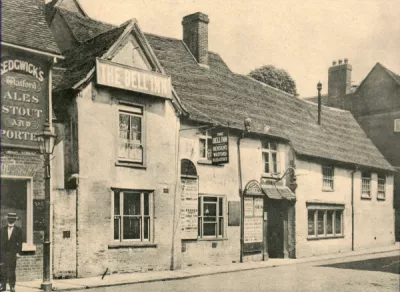
Rickmansworth is undeniably and firmly in Metroland - the pre-WW2 expansion of London along the Metropolitan Railway heading for the Chilterns. Other articles in this section will have much more detail of that: and, of course, Croxley Green and Chorleywood, in fact much of the area, were also 'Metroland'.
But it wasn't always so! The area around Rickmansworth is known to have been inhabited since the Stone Age and various flints have been found in local gravel pits. These gravels would have been laid down during or after the Ice Age.
The Neolithic Age preceded the Bronze Age (ie 5 - 4000 BC). The three rivers - Colne, Gade and Chess - may have attracted early man to this area.
c1800 BC Man began to use bronze tools/weapons, evidence of which has been found in the Chess Valley.
Iron Age - 700 BC Traces of occupation during this period have been found in the Chess Valley and at Harefield.
1st Century BC The local tribe here, the Catuvellauni, had probably become quite civilised. This tribe may also have included some of the original Britons to fight against Julius Caesar’s Roman invasions of 55 and 54 BC. Britain was left alone for many years by the Romans until 43 AD when they returned and settled in (amongst many other areas) the river valleys around here. There is evidence of Roman villas at Latimer and Sarratt in the Chess Valley and at Moor Park and Sandy Lodge along the Colne Valley. In the hypocaust ashes of a building excavated at Moor Park, four coins were found and a bronze finger ring engraved with a device of an ear of corn or branch flanked by two birds. Similar designs are known from five other rings of the 4th Century found in Britain.
4th Century AD Britain was subjected to numerous Saxon raids from the Continent.
At the beginning of the 5th Century AD Britain was no longer controlled by the Roman Empire after the breakdown of government in Rome. This caused a decline in the local economy. The country did not revert to uncivilised ways immediately, the breakdown being gradual. Evidence shows that the Moor Park villa was still in use into the middle of the 5th Century but then fell into decline.
Dark Ages Very little is known about this specific period, although this area was under the rule of the Saxon king, Offa, whose kingdom was called Mercia. King Offa, who died in 796AD, founded the Abbey of St Alban. He was succeeded by his son Egfrith who, to gain favour, presented the Manor of Pynnelsfeld, West Hyde and five farmsteads to the Abbey. There is known to have been a settlement at Rickmansworth during this period, its name Rykmeresworth being derived from the Saxon personal name ‘Rykmer’ and ‘worth’ which means farm.
In the Domesday Survey (below) it was recorded under the name of the Manor of Prichemeresworde.
CHRONOLOGY
793 to 1400 AD
793 Offa, King of Mercia, granted the Abbey of St Alban forest land to the southwest of the abbey.
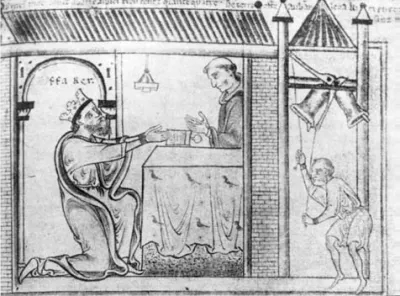
796 Ecfrith, son of Offa, granted ‘The Pynesfield Charter’ (above), which gave five farmsteads in Pynnelsfeld to the Abbey of Alban.
1048 - c1066 Five hides of land at Croxley (in the newly-formed Manor of Prichemeresworde), were defined as a home farm for the Abbey of St Alban.
1086 ‘Prichermeresworde’ valued at £20 l0s in the
Domesday Book.
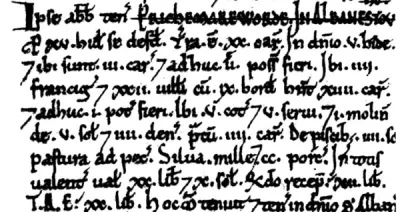
The Rickmansworth entry in the Domesday Book translates as:
‘The Abbot [of St Albans] holds Rickmansworth in Albanestan Hundred. It is rated at 15 hides. The arable is now 20 carucates*, in desmesne 5 hides, and there are 3 carucates and two more may be made.
There are 4 Frenchmen born and 22 villeins with 9 bordars, having 14 carucates and now one more may be made. There are 5 cottagers and 5 servants and one mill worth 5s 4d. Meadows 4 carucates, in fish 4s. by the year, common and pasture for the cattle, woodland, 1200 hogs.
In the whole value it is worth £20 10s by the year, when he received it £12, in the time of King Edward £20. He held and doth hold the manor in the demesne of St Albans.’
* a carucate is the land a team of eight oxen could plough in a season.
1100 - c1150 Substantial properties within the Manor of Rickmansworth were granted as ‘knights fees’, including Batchworth, Pinesfield, Woodwicks and the demesne lands of Croxley.
1219 The church at Rickmansworth confirmed to the Abbey of St Alban.
1257 The Manor of Croxley reverted to the ownership of the Abbey of St Alban.
1269 Batchworth granted the right to hold an annual fair.
1294 (November) Rickmansworth visited by Edward, Prince of Wales.
c1300 The Manor of Pinesfield reverted to the ownership of the Abbey of St Alban.
1381 Revolt of the tenants of St Albans Abbey. A charter was issued to Rickmansworth confirming their rights but it was rescinded three weeks later.
15th Century
c1400 Croxley Great Barn (pictured below) built. It was not a ‘tithe’ barn, but one of eight ‘kitchen barns' for the abbey. You can read more about the Great Barn here.
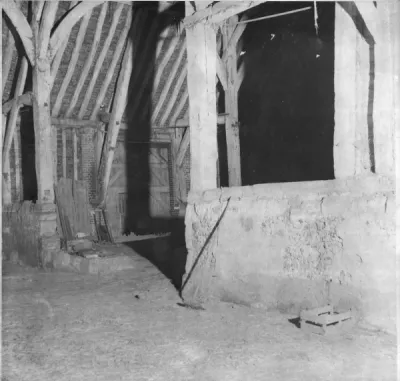
1426 Licence given to the owner of the Manor of the More, William Flete, to enclose 600 acres of Rickmansworth and Watford lands to form Moor Park. You can read more about the Manor of the More here.
1456 Ralph de Boteler, Lord Chamberlain to Henry VI, held the Manor of the More and the Park.
1460 The Manor of the More and the Park reverted to St Albans Abbey.
c1469 George Nevil, Archbishop of York, leased the Manor of the More.
1472 George Nevil arrested and the Manor of the More seized by Edward IV.
1486 John de Vere, Earl of Oxford, granted the Manors of More, Ashleys, Batchworth, Brightwell and Eastbury in tail male by Henry VII.
You can read much more about Rickmansworth in the fifteenth and sixteenth centuries in the Historical Society's book by Dr Heather Falvey The Pre-Reformation Wills of Rickmansworth parish 1409-1539, available in the museum, and about life at this time here.
16th Century
c1500 The White Bear public house built.
1513 (10th March) John de Vere, Earl of Oxford, died without male heirs, so the Manor of the More and its accompanying manors reverted to the Crown.
(April) Manor of the More leased to Thomas, Bishop of Durham, for seventy years at an annual rent of £62 0s 4d.
1514 Linsters Estate, part of the Manor of Ashleys, leased to the Masters of the Savoy Hospital, London, by the Crown.
1515 (May) The Manor of the More granted to the Abbey of St Albans for 3,000 marks subject to the lease held by the Bishop of Durham.
1522 Cardinal Thomas Wolsey, Chancellor of England, became Abbot of St Albans Abbey ‘in commendam’.
Arson attack on Rickmansworth Church, possibly by Lollard extremists.
Wolsey’s Indulgence issued, granting 100 days release from purgatory to all those who would repair Rickmansworth Church after the fire.
1525 (30th August) ‘The Treaty of the More’ (a peace treaty between England and France) was signed at the Manor of the More.
1529 (10th-29th September) King Henry VIII and Queen Catherine of Aragon stayed at the Manor of the More, as guests of Cardinal Wolsey. Wolsey was, in fact, about to fall from power.
1530 (29th November) The Abbot of St Albans Abbey ‘in commendam’, Cardinal Thomas Wolsey, died.
1531 (5th September) The Abbot of St Albans, Robert Catton, granted King Henry VIII the Abbey lands of the More, Ashleys, Batchworth, Brightwell and Eastbury.
King Henry VIII granted Sir John Russell the post of Keeper of the Manor of the More and Bailiff of the Lordship of the Manor of Rickmansworth.
(November 1531-May 1532) Queen Catherine of Aragon resided at the Manor of the More.
1535 The Manor of Rickmansworth leased to William Hutchyson for 40 years.
1538 The Manor of Croxley leased to William Baldwin of Red Heath for 44 years.
1539 (9th December) Robert Boreman (or Stevenage), Abbot of St Albans Abbey, surrendered the Abbey of St Albans.
The Bury, the farm of the Manor of Rickmansworth, leased to John Palmer for 31 years.
The Manor of Pinesfield leased to John Randulph for 41 years.
1541 Henry VIII and Queen Catherine Howard stayed at the Manor of the More for three weeks.
1542 The Bailiff, men and inhabitants of Rickmansworth granted a licence by Henry VIII to hold a Saturday market and a fair on the feast of the Assumption.
1544 Mill at Rickmansworth leased to William Hutchinson, yeoman of the spicery, and his wife Janet.
1550 (April) Edward VI granted the Church, Manor, Rectory and Advowson of the Vicarage of Rickmansworth to the Bishop and Diocese of London.
The Manor of Pinesfield also granted to the Bishop and Diocese of London.
The Manor of Croxley granted to Robert Lee.
1551 John Russell, Earl of Bedford, surrendered the offices of Keeper of the Manor and Park of More, and Bailiff of the Lordship or Manor of Rickmansworth, Hertfordshire. It was re-granted to the Earl of Bedford and his son Francis Russell in survivorship.
1553 Linsters Manor granted to St Thomas’ Hospital, London.
1556 The Manor of the More taken into the charge of the Court of Augmentations.
1556/7 The Manor of Croxley granted to John Caius, Physician to Queen Elizabeth.
1557 The Manor of Croxley used by John Caius (pictured below) to endow Gonville College, Cambridge.
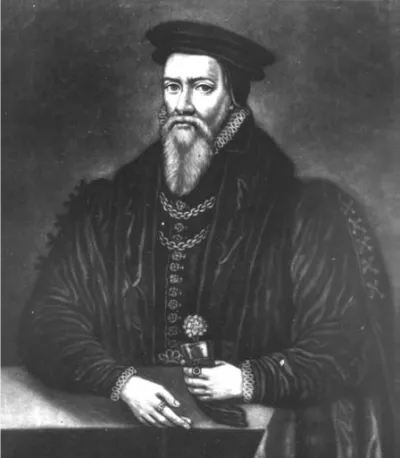
1558 Reversion of the Manor of Croxley granted to Gonville and Caius College, Cambridge, by John Caius.
The Manor of the More granted to the Duchy of Lancaster.
John Palmer, lessee of The Bury, the farm of the Manor of Rickmansworth, died. He bequeathed the remaining twelve years of his lease to his wife Margaret.
1559 The Manors of Rickmansworth and Pinesfield acquired by Queen Elizabeth in lieu of Impropriated Churches granted to the Bishop of London.
1563 Rickmansworth Mill (the corn mill at Batchworth) leased to John Wylson.
1570 Woodwicks Manor held by Robert Colte.
1573 The Bury, the farm of the Manor of Rickmansworth, leased to Margaret Palmer, widow of John Palmer, for 21 years.
1576 The Manor of More and Moor Park granted to Francis Russell, 2nd Earl of Bedford, at a rental of £120 per annum by Queen Elizabeth.
The mill of Rickmansworth Manor leased to Richard Master, 'the Queen’s Servant'.
1585 (28th July) Francis Russell, 2nd Earl of Bedford, owner of the Manor of the More and Moor Park, died and was succeeded by his grandson Edward, aged eleven.
1586 Lynsters Farm leased to Rowland Beresford for 21 years.
1588/9 The Bury, the farm of the Manor of Rickmansworth, leased to Francis Palmer for 21 years.
1589 Rev William Edmonds BA instituted Vicar of Rickmansworth.
1591 The Manors of Rickmansworth and Pinesfield confirmed as in the ownership of Queen Elizabeth.
1591/2 Pinesfield Manor leased to George Kirkham for 21 years.
17th Century
1610 The Bury House and grounds leased to Sir Gilbert Wakering for 60 years.
The Lordship and Manor of Rickmansworth granted to Henry, Prince of Wales.
1614 Edward Russell, 3rd Earl of Bedford, and his wife Lucy, Countess of Bedford, took up residence at Moor Park.
1616 The Lordship of the Manor of Rickmansworth granted to trustees for Charles, Prince of Wales.
1620 Edward Russell, 3rd Earl of Bedford and his wife Lucy built a seventeen roomed mansion in Moor Park.
1621 The Manor of Rickmansworth mortgaged to Sir Richard Smith.
1627 (3rd May) Edward Russell, Earl of Bedford, died.
(26th May) Lucy, Countess of Bedford, died.
The Manor of the More and Moor Park bought by William Herbert, 3rd Earl of Pembroke.
1628 William Herbert, 3rd Earl of Pembroke, became Lord of the Manors of Rickmansworth (including the market house) and Pinesfield.
1630 William Herbert, 3rd Earl of Pembroke, owner of the Manor of the More and Moor Park, and the Manors of Rickmansworth (including the market house) and Pinesfield, died and was succeeded by his brother Philip.
1631 Philip, 4th Earl of Pembroke, sold the Manor of the More to Sir Charles Harbord and the Mansion and Park of More to Robert Carey, Earl of Monmouth.
1632 The Manors of Rickmansworth and Pinesfield sold by Philip, 4th Earl of Pembroke, to Thomas Fotherley.
1639 Robert Carey, Earl of Monmouth, owner of Moor Park, died aged 80 and was buried in Rickmansworth Church.
1640 (31st March) Thomas Fotherley knighted at Whitehall by Charles I.
1641 Edward Forde published ‘A Design for bringing a navigable river from Rickmansworth in Hertfordshire to St Giles in the Fields (London)’.
1644 Thomas Walley intruded as Vicar of Rickmansworth.
1646 George Swinnock appointed Vicar of Rickmansworth by the Committee of Plundered Ministers after the resignation of Thomas Walley.
1649 James, Job and Edward Lane of Shepherds Farm, Rickmansworth, emigrated to America.
Sir Thomas Fotherley, Lord of the Manor of Rickmansworth and tenant of Parsonage Farm, died and was succeeded by his son John.
1652 John Fotherley appointed Sheriff of the County of Hertford.
1655 Sir Charles Harbord sold the Manor of the More to Sir Richard Franklin.
Henry Carey, 2nd Earl of Monmouth, sold Moor Park to Sir Richard Franklin.
1657 John Beresford of Rickmansworth appointed Sheriff of Hertfordshire.
1660 Rev William Edmonds restored as Vicar of Rickmansworth.
1661 Henry Carey, 2nd Earl of Monmouth, died at Rickmansworth and was buried in the parish church.
1663 John Beresford died and bequeathed two tenements in Rickmansworth High Street for Almshouses.
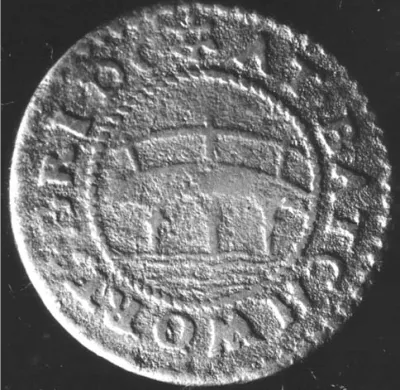
1664 James Butler, Duke of Ormonde, and his wife Elizabeth, purchased Moor Park for £10,500 from Sir Richard Franklin.
1666 Thomas Butler, Earl of Ossory, son of the Duke of Ormonde, summoned to the English House of Lords as Lord Butler of Moor Park.
1670 Moor Park Mansion sold by Duke of Ormonde to James Fitzroy, Duke of Monmouth, natural son of Charles II.
1672 (4th April) William Penn and Gulielma Springett married at Kings Farm, Chorleywood and set up house in Rickmansworth.
Sir Richard Franklin sold the Manor of the More to Sir John Bucknall.
1675 Richard Baxter, the Presbyterian Divine, preached at Rickmansworth church. He also had a day-long debate with William Penn.
1678/9 James, Duke of Monmouth, erected a new house in Moor Park.
1681 William Ford died and bequeathed £100 to buy land, the rent of which was to be used for the benefit of the poor.
1682 Almshouses constructed in Rickmansworth High Street by John Fotherley, Lord of the Manor of Rickmansworth.
1685 James, Duke of Monmouth, owner of Moor Park, conspired to overthrow his uncle, James II.
(15th July) James, Duke of Monmouth, was executed for his part in the ‘Monmouth Rebellion’ and his estates were sequestered.
1688 The widowed Duchess of Monmouth, owner of Moor Park, married Lord Cornwallis.
1690 Rev John James instituted Vicar of Rickmansworth.
18th Century
1702/3 (14th January) John Fotherley, Lord of the Manor of Rickmansworth buried, aged about 80.
1703 The Manor of Rickmansworth passed to John Fotherley’s widow, Dorothy.
1708 Lady Ann Franklin by her will directed that a yearly sum of £10, free of taxes, issuing out of the Moor Park estate, should be distributed amongst the poor.
1709 Mrs Dorothy Fotherley, Lady of the Manor of Rickmansworth, buried at Rickmansworth Parish Church.
Temple Whitfeld, nephew of Mrs Dorothy Fotherley, inherited the Manor of Rickmansworth.
1711 Rickmansworth Charity School founded by the Rev John James, Vicar of Rickmansworth.
1720 Benjamin Styles bought Moor Park mansion from the Duchess of Monmouth.
The Elms in the High Street and The Cedars at Money Hill were built.
c1720 Salter and Woodman’s brewery built in the High Street.
1722 Batchworth Bridge renewed by Temple Fotherley Whitfeld.
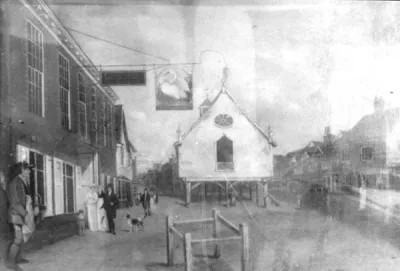
1730 (9th December) Temple Fotherley Whitfeld died, succeeded by his brother Henry.
1735 Henry Fotherley Whitfeld died, succeeded by Henry his son.
1739 (4th April) Benjamin H Styles died and his nephew, Francis Haskins Eyles Styles, succeeded to the More Park estate.
1740 Basing House re-built. Cart and Horses public house (now Vantage Chemists on the corner of the High Street and Bury Lane) built.
1744 Batchworth Bridge renewed by Henry Fotherley Whitfeld.
1746 Solesbridge Mill started paper production.
1747 Henry Fotherley Whitfeld died. (11th Jan 1748 by current calendar)
1750 Samuel Salter, of Salter’s Brewery, died.
1752 (or 1754) Admiral Lord Anson (1697 - 1762) purchased Moor Park from Court of Chancery.
1757 Scotsbridge and Hamper Mills started paper production. A new mill was built at Batchworth at about this time, next to the ancient corn mill, and may also have been used for paper.
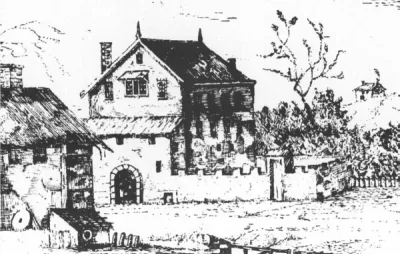
1758 John Alexander vicar of Rickmansworth.
Loudwater Mill started paper production.
1762 Henry Fotherley Whitfeld chosen Sheriff of Hertfordshire.
Admiral Lord Anson dies at Moor Park
1763 Moor Park purchased by Sir Laurence Dundas from Lord Anson's estate.
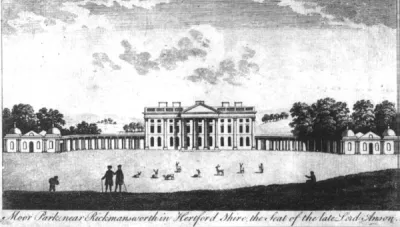
1785 Sir Thomas Dundas sells Moor Park to Thomas Bates Rous, a director of the East India Company.
Batchworth Mills had passed to the brothers John and Joseph Strutt by this time, and the new mill was being used for cotton thread spinning.
1793 Parliamentary Act passed for the building of the Grand Junction Canal from Braunston to Brentford via Rickmansworth.
1795-96 Extreme winter weather caused great hardship in Rickmansworth, as in many places across the country. Flooding after thaw washes away Batchworth Bridge – replaced by a temporary structure to keep the London Road open. Thomas Bates Rous leads a public effort to provide food for the poor.
1796 Grand Junction Canal became operational from Rickmansworth to Brentford.
1797 First ‘Good Fellowship’ Society founded in Rickmansworth at The Swan by Thomas Dawbinney, the inn keeper.
19th Century
1801 Robert Williams, prominent in the East India Company, bought Moor Park estate on the death of Thomas Rous.
1802 The Barn at the back of the Coach and Horses public house registered as a meeting place for the Baptist community in the town.
1804/5 Salter’s Arm on the Grand Junction Canal constructed.
c1805 Rickmansworth Park House built.
1806 Market Hall pulled down in centre of Rickmansworth High Street and re-erected in line with the shops.
Thellusson Trustees bought Pinesfield Manor from Henry Fotherley Whitfeld.
Rickmansworth Silk Mill (now M&S site in the High Street) opened, almost certainly powered by horses.
1807 Original pair of John Beresford Almshouses pulled down and four new Almshouses built further back on the site in the High Street.
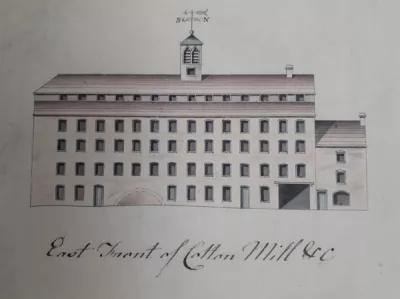
1809 London road becomes the Rickmansworth, Pinner and Harrow Turnpike, running from Church Street to Sudbury roughly along what is now the A414.
1811 Batchworth Mill bought by the Grand Junction Canal Company from John Strutt for £16,400.
Rickmansworth Parish Statistics: population 3,230, acreage 10,021.
Henry and Sealy Fourdinier lease Batchworth Mill from the Grand Junction Canal Company, as a paper mill.
1813 Henry Fotherley Whitfield of The Bury and Rickmansworth Park dies.
1815 Shepherds Farm bought by the Thellusson Trustees.
First Methodist Society meet in a cottage at Bankside Downs.
Woodoaks Manor bought by Robert and William Williams of Moor Park from Samuel and Hannah Leightonstone.
1817 The boys’ half of the Rickmansworth Charity School moved to the Market House.
1818 Rickmansworth Association formed (for the defence of property).
1819 The Fourdriniers, already bankrupt, relinquish their lease on Batchworth Mill. John Dickinson leases the mill from the Grand Junction Canal Company, for preparing pulp for paper making.
1820 White Hart Inn (the site of Boots the Chemist in the High Street) closed.
The small brewhouse at the Gorrells, behind the High Street west of Bury Lane, closed.
1821 Rickmansworth Parish Statistics: population 3,940, acreage 10,021.
1826 The Pre-Reformation church at Rickmansworth demolished and a ‘Commissioners Church’ built in its place. Architect: William Atkinson.
1827 Woodoaks Farm purchased by Thellusson Trustees.
1828 Moor Park bought by Robert, 2nd Earl Grosvenor.
1829 The Bury sold to Alfred George Muskett.
The Lordship of the Manor of Rickmansworth sold to William Windale.
Samuel Salter died.
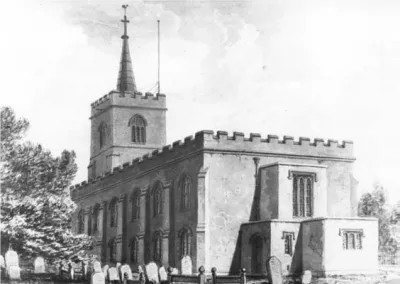
1830 Rickmansworth Silk Mill rebuilt by Thomas Rock Shute of the Watford Rookery silk mill, and given steam power.
1831 The Lordship of the Manor of Rickmansworth sold to William Dimes.
Rickmansworth Park bought by Mrs Temperance Arden, widow of John Arden of Islington.
Robert, 2nd Earl Grosvenor became Marquis of Westminster on the occasion of William IV’s coronation.
Rickmansworth Parish Statistics: population 4,574, acreage 10,021.
1832 The Reform Act passed, with some disturbance in Rickmansworth as elsewhere. A report of this by Sophia Percy, resident at Scotsbridge House, can be read here.
1833 (16th June) King William IV and Queen Adelaide visited Moor Park as guests of the Westminsters.
Kings College Cambridge buys Troy Farm, West Hyde.
William Dimes forced to rebuild Batchworth Bridge as he was Lord of the Manor of Rickmansworth. A cast iron bridge was installed, pictured below:
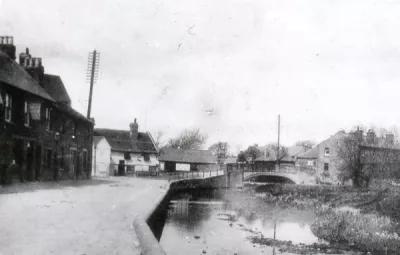
1836 Emmot Skidmore of Frogmore House died.
'New Poor Law'. Incorporation of Rickmansworth parish into Watford
Poor Law Union, with the new Union Workhouse established in Vicarage
Road, Watford.
1837 (September) The former Rickmansworth Workhouse site sold for £137 13s 5d to provide the premises for a new charity school, now next to what is now the Baptist Church in the High Street.
1839 Tithe survey of Rickmansworth and Chorleywood. Among the notable detail is the farm land holdings of William White of Appletree Farm, Chorleywood and his son John, of Parsonage Farm, Rickmansworth.
1841 Census figures for Rickmansworth Parish: population 5,026, acreage 10,021.
John White began to keep his detailed farm amd personal diary on his marriage to Sophia Powell.
1843 Baptist Chapel built in the High Street at a cost of £800.
Methodist Chapel built in the High Street.
Joseph Arden inherited Rickmansworth Park estate after the death of his mother, Mrs Temperance Arden.
1845 (6th May) Church of St Thomas of Canterbury at West Hyde consecrated. James Green first incumbent.
(3rd December) A new ecclesiastical parish was formed in Chorleywood.
(l7th December) Robert Grosvenor, 1st Marquis of Westminster, owner of Moor Park estate, died.
1846 (March) Herringsgate Farm sold to Fergus O’Connor on behalf of the Chartist Land Company.
(21st October) Queen Victoria and Prince Albert visited Moor Park Mansion when staying at Cassiobury.
(3rd November) West Hyde became a separate ecclesiastical parish.
(November) Eleanor, Marchioness of Westminster, died and Lord Robert Grosvenor inherited the Moor Park Estate.
1847 (1st May) Opening ceremony of the O’Connorville Chartist estate at Heronsgate. More on the story of Heronsgate is here.
1848 Herbert Ingram, proprietor of the ‘Illustrated London News’ bought Loudwater Mill because he wanted to manufacture his own paper. He subsequently built his house, called Glen Chess, alongside.
1849 Queen Dowager visited Moor Park Mansion with Queen Victoria and Albert.
1851 Census figures for Rickmansworth Parish; population 4,851, acreage 10,021.
The National School in the High Street built in front of the old workhouse.
Triumphal arch built for Queen Victoria when she passed through the town.
1852 Rickmansworth Gas Light & Coke Company formed, with a new gas works built near Town Wharf.
1854 Queen Victoria and Prince Albert paid a return visit to Moor Park Mansion.
1856 Land for Chorleywood Road cemetery bought from Parsonage Farm.
1857 (February) St Mary’s Churchyard closed for burials.
Lord Robert Grosvenor raised to the peerage as 1st Baron Ebury.
O’Connorville estate sold at auction.
1860 (3rd July) Watford & Rickmansworth Railway Act received The Royal Assent.
(22nd November) first sod cut for the Watford & Rickmansworth Railway.
Gerald Massey, the Chartist poet, lived at The Limes, Rickmansworth High Street (now Watersmeet) for a period of four years at about this time.
1861 Part of Townfield, Parsonage Farm, sold as a site for Parsonage Road School, an infants’ school.
A Parliamentary Act changed the area in which coal taxes were to be paid to the Metropolitan Police Districts and therefore ‘Coal Posts’ were set up on the Middlesex county boundary. Stockers House built for the Collector of Coal Duties, on Stockers Farm land.
A school was built in West Hyde.
Census figures for Rickmansworth: population 4,873, acreage 10,021.
1862 (1st October) Watford & Rickmansworth Railway opened to traffic.
1863 Rev Dr William Flavell Hurndall opened Cedars School for boys in Money Hill.
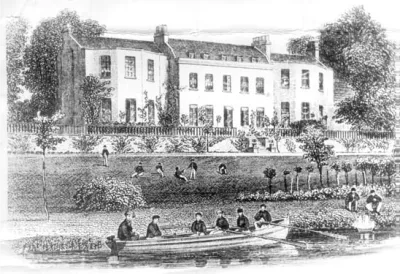
1864 A house in Talbot Road became Rickmansworth’s Police Station until 1897, when it moved to the High Street .
W H Brown was appointed master of the Rickmansworth Boys National School, and remained until he retired in May 1894.
1865 Rev Robert Bayne, Minister of Rickmansworth Baptist Church, wrote two books on the locality called ‘Rickmansworth and its Neighbourhood’ and ‘Moor Park’.
1866 Methodist Chapel (below) built on the corner of Wharf Lane and the High Street to replace the one burnt down in 1865. The chapel was consecrated on 26th November.
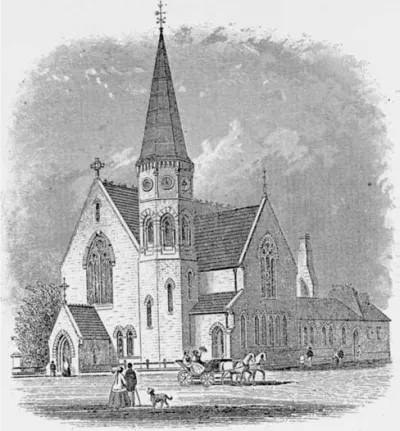
1867 Lord Robert Grosvenor, 1st Baron Ebury, bought the Manor of the More from Thomas Sotherton whose family had owned it since 1672, thereby reuniting the Manor and Park of More.
Penny Reading Society started in Rickmansworth with W H Brown, headmaster of the Rickmansworth Boys National School, as the first secretary.
1868 John Saunders Gilliat, owner of The Cedars at Chorleywood, purchases the Lordship of the Manor of Rickmansworth.
1869 Rickmansworth Town Hall Company registered in May and the new Town Hall building formally opened at Christmas.
Gilham’s Boot Manufacturer’s shop opened in the High Street (now Thomas Cook).
Rickmansworth Voluntary Fire Brigade formed at the instigation of Dr Roderick Henderson, with Thomas Fellowes, Salter’s Brewery manager, as its first Captain. The story of the Fire Brigade is in more detail here.
1871 Census figures for Rickmansworth Parish: population 5,337, acreage 10,021.
Parsonage Farm bought by John Saunders Gilliat of The Cedars, Chorleywood for £8,500.
1872 (25th June) All Saints Church, Croxley Green, consecrated and the ecclesiastical parish of Croxley Green subsequently formed.
1874 Enlarged school for girls and infants opened on the Parsonage Road site.
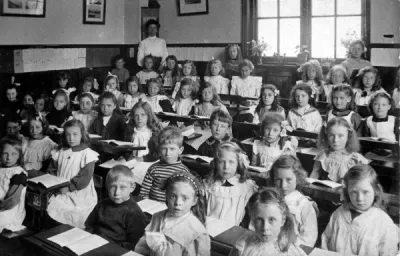
(27th July) Mill End National School for Girls and Infants opened.
Harrow and Rickmansworth Railway Act passed, but repealed 1878 without any work being carried out.
West Hyde School opened to become the West Hyde National School.
1875 (1st April) St Peter’s Church at Mill End consecrated and the ecclesiastical parish of Mill End subsequently formed with Charles Wallace Neild as vicar.
George Eliot (pen name of Mary Ann Evans) took a house (The Elms) at Rickmansworth for the summer whilst she was writing the novel Daniel Deronda.
The very poor weather of the previous several years continued, causing an agricultural depression which was to last 20 years and result in great hardship here and widely across the country.
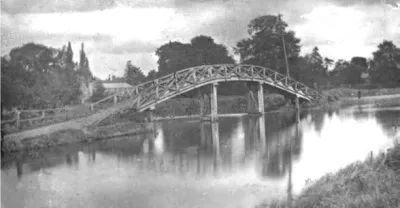
1879 Lord Ebury purchased The Bury and its grounds, at Rickmansworth.
(October) John William Birch bought Rickmansworth Park estate after the death of his father-in-law, Joseph Arden.
1880 (6th August) Rickmansworth (Extension) Railway Act passed.
Rickmansworth Silk Mill appears to have closed.
1881 Census figures for Rickmansworth Parish: population 5,511, acreage 10,021.
1883 H J Dyer became Minister of the Rickmansworth Baptist Chapel, later together with Mill End and Harefield Chapels.
Rev Dr Hurndall’s Cedars School closed due to his illness. The Inebriates Association acquired the Cedars School premises and opened a treatment hostel.
1884 Rickmansworth Water Company’s first Act passed.
1885 Loudwater Mill closed down due to legal action against it for polluting the River Chess.
Riots on election night: Rickmansworth Conservative Committee Rooms attacked by mob.
Rickmansworth & Uxbridge Valley Water Company formed by a new act.
1886 Chancel added to the chapel at Heronsgate; it re-opened on 6th October as St John the Evangelist, Heronsgate.
1887 Metropolitan Railway completed from Harrow to Rickmansworth. The first train ran from Baker Street to Rickmansworth on 1st September. Part of the report of the Watford Observer is here.
1888 Solesbridge Mill and Mill End Mill closed down when owner George Austin became bankrupt.
Work began building the R&UV Waterworks at Drayton Ford and the reservoir at The Swillett.
1889 Foundation stone for extension to Salter’s Brewery in the High Street laid.
R&UVWC works at Drayton Ford opened and piped supplies became available in Rickmansworth.
Goodlake Memorial Hall built at West Hyde.
Last day of ‘Defiance’ stage coach between Chenies, Rickmansworth and Piccadilly.
1890 St Mary’s Church Rickmansworth rebuilt except for the tower; with Arthur Bloomfield as the architect.
Mill End Mill re-opened by the newly-formed Mill End Paper Company, continuing business until 1905.
London and County Bank built in the High Street (later Westminster & then National Westminster).
1891 Census figures for Rickmansworth Parish: population 6,974, acreage 10,021.
Fire Station in the High Street built at the expense of Dr Henderson of Basing House, who had been the Captain (Chief Officer) of the Brigade since the 1870s.
Lady Ebury, wife of 1st Baron Ebury of Moor Park, died.
1893 (November) Lord Ebury, 1st Baron Ebury, died aged 92.
1894 Under the Local Government Act of this year Rickmansworth opted to have a Parish Council rather than be part of greater Watford in the Watford Urban District Council.
(4th December) The first Parish Councillors elected.
Tom Bevan appointed headmaster of Rickmansworth Boys National School.
Beresford Almshouses built in Bury Lane, replacing those of the same name in High Street.
1895 (May) Albert Freeman came to Rickmansworth to be surveyor to the Rickmansworth Highway Board, and later to the UDC.
1896 Rickmansworth News published.
(December) Rev C Wallace Neild, first Vicar of St Peter’s, Mill End, died.
1897 Police Station opened in the High Street adjoining the Fire Station.
John William Birch died and the Rickmansworth Park estate inherited by his wife, Julia.
1898 Rickmansworth achieved Urban District Council status; population 5,780 and acreage of UDC 572. Included were Rickmansworth Town, Batchworth, Croxley to the rear of New Road, and Mill End to Long Lane. Henry Lomas was Clerk to the Council.
(29th December) Inauguration of Rickmansworth Traders’ Association.
1899 (l7th January) Inaugural General Meeting of the Rickmansworth Traders’ Association held at Fire Engine House. Colin Taylor elected President.
Rickmansworth & Uxbridge Valley Water Company acquired Batchworth Mill, which had been given up by Dickinson in 1878.
The Volunteer Firemen photographed in 1901 outside the Fire Station in the High Street. Part of the fire station site is now a fish & chip shop.
20th Century
1900 Franklin’s Mineral Waters took over the old silk mill at the west end of the High Street.
Proposal to build a tramway from Watford to Rickmansworth launched.
Gravel extraction started on Bury Farm by Daniel Bone, tenant farmer.
1901 Sewerage scheme started in Rickmansworth. 1,800 acres of land at Batchworth purchased from Lord Ebury for a sewage farm at a cost of £375.
(October) Ebury Rooms (formerly Mission Rooms) opened, donated by Lord Ebury.
Census figures - Rickmansworth Civil Parish: population 8,232 and acreage 10,021.
UDC: population 5,640, acreage 572, houses 1,274.
Rickmansworth Cycling Club for Men started.
Horse troughs at the top of Scots Hill and at the junction of High Street and Uxbridge Road donated by the Metropolitan Drinking Fountain and Cattle Trough Association. Money had been collected by Mrs Ibbotson & others from the Wesleyan Methodist Chapel.
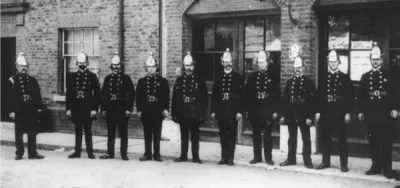
1902 Messrs H W Sabey & Company excavated Batchworth Meadows for gravel, the lake thus formed becoming known as Sabey’s Pool. Gravel was taken onto the canal though a lock onto the river Chess.
Rickmansworth Gravel Company formed and started extracting gravel at Croxley Long Valley Woods.
1903 (June) Floods in Rickmansworth. 18 inches of water along Harefield Road.
1904 (7th March) first house in Rickmansworth connected to the new sewerage scheme.
Rickmansworth Gas Company acquired by the Rickmansworth UDC for £26,950.
The Religious Order of the Daughters of Jesus established themselves in Rickmansworth.
Barclays Bank opened in Church Street.
1905 Beaumont House School founded in Heronsgate with Walter Giffard as headmaster.
William Henry (‘Harry’) Walker set up as a coal and timber merchant at Frogmore Wharf and on land in Harefield Road, leased from Lord Ebury.
Mill End Paper Company sold to Peter Clutterbuck.
Rickmansworth UDC acquired new council offices in Church Street.
1906 The bed of the old mill stream of Batchworth Mill filled in for the widening of the London Road.
St Monica’s School, a free elementary school for Catholic children, opened in Rickmansworth High Street.
View from the chimney of Batchworth Mill when it was about to be demolished
and after the Rickmansworth Water Company had bought the site.
William Dimes’ iron bridge of 1836 over the Colne is in the lower foreground.
1909 Swimming pool in Ebury Road opened on land presented by Lord Ebury.
(26th October) Our Lady Help of Christians Catholic Church opened by Archbishop Bourne.
First Rickmansworth Scout Troop formed, known as ‘Lady Ebury’s Own’.
Joan of Arc Convent opened at Englefield, 11 High Street, Rickmansworth.
1910 Golf course at Sandy Lodge opened. Sandy Lodge Halt on the Metropolitan Line opened.
Rickmansworth’s first cinema, the Electric Picture House, opened in the converted Town Hall in the High Street.
Accession of King George V.
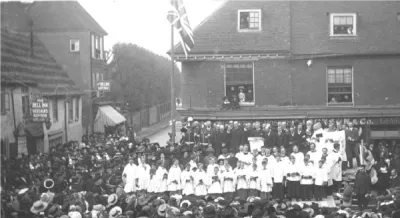

Batchworth Mill demolished (above)
1911 Ebury Recreation Ground opened by Lord Ebury on land given to the town by him.
Census: Rickmansworth Civil Parish: 9,844 people and 10,021 acres.
Rickmansworth UDC area: 6,288 people, 572 acres and 1,447 houses.
1912 The mill at Mill End demolished.
J S Gilliat of The Cedars, Chorleywood, died. A governor of the Bank of England in the 1880s, he was the Lord of the Manor of Rickmansworth from 1868 until his death.
Rickmansworth Golf Club formed.
1913 The White Bear public house at Batchworth rebuilt.
The White Bear, Batchworth, in 1904, before rebuilding in 1913. The rebuilt White Bear public house can be seen in the lower left corner of the ‘birds eye’ photograph above. |
Rickmansworth Urban District increased its acreage from 572 to 2,818 with the inclusion of Croxley as far as Cassio Bridge, Loudwater and Heronsgate from Rickmansworth Rural District Council; population now 2,011 and 1,590 houses.
W. H. Walker & Bros purchased the freehold of Batchworth Lake for £3,600 plus £200 for the surrounding land from the Moor Park Estate.
1914 A county council school opened in West Hyde next door to the church of St Thomas.
Croxley and Mill End gravel pits investigated on behalf of the British Museum.
1915 600 soldiers and 500 horses with gun carriages of the Third London Brigade, Royal Field Artillery, stationed in the town from March to May.
1917 Rickmansworth and Chorleywood War Savings Association started with Albert Freeman as Hon Treasurer.
Mrs Julia Birch of Rickmansworth Park estate died aged 89.
1918 30 German prisoners of war quartered in the Stables of Rickmansworth Park.
(November) Robert Wellesley Grosvenor, 2nd Baron Ebury of Moor Park died aged 84.
1919 Metropolitan Railway Country Estates Ltd bought 454 acres of the Chorleywood Cedars estate for £40,000 from Col. Babington Gilliat.
1920 German howitzer presented to the town by the War Office and placed in the Ebury Recreation Ground.
House numbering started in Rickmansworth.
Lord Leverhulme purchased Moor Park Estate and formed Moor Park Ltd to develop its potential.
1921 Census: UDC: population 7,150, acreage 2,818, houses 1,67l.
Rickmansworth area: population 7,515, acreage 2,790.
The first council houses in Rickmansworth completed at Grove Road, Mill End and Gonville Avenue, Croxley Green.
(31st July) Rickmansworth War Memorial unveiled at Ebury Recreation Ground by Field Marshal Earl of Cavan.
Rickmansworth Branch of the Royal British Legion formed.
(December) Robert Victor Grosvenor, 3rd Lord Ebury, died.
1922 Redheath sold to 4th Lord Ebury for £27,000.
St Joan of Arc Convent and School moved into The Elms in Rickmansworth High Street.
The newly formed Rickmansworth and District Omnibus Company erected a bus garage in Park Road, Rickmansworth (later Wrights Garage).
1923 Moor Park Ltd opened the Moor Park Club with 3 golf courses, 12 tennis courts and 2 croquet lawns.
British Legion Club House in Ebury Road opened.
Sandy Lodge Halt on the Metropolitan Railway Line renamed Moor Park and Sandy Lodge Station.
1924 Salter’s Brewery in Rickmansworth ceased production after being taken over by the Cannon Brewery of Clerkenwell.
1925 (March) Mr Colin Taylor, President of the Rickmansworth Traders Association since its inception, died.
Metropolitan Railway electrified from Harrow to Rickmansworth.
Rickmansworth Sand and Gravel Company formed to extract gravel from Bury Lake.
Rickmansworth Fire Brigade taken over by Rickmansworth UDC.
1926 Rickmansworth Park estate sold to the Royal Masonic Institution for Girls by Viscountess Barrington.
Morelands Concession formed to continue the development of Loudwater estate.
The Women’s Section of the Rickmansworth Branch of the Royal British Legion formed.
1927 Purpose-built cinema, The Picture House (shown opposite), constructed on the yard of the former Salter’s Brewery.
Twenty acres of Rickmansworth Park given to the town by the Royal Masonic Institution for Girls.
A slight earthquake shock felt in Rickmansworth during August.
The Council contractor for refuse removal, the Scavenger, outside the newly opened Picture House. |
1928 (January) Floods in Park Road, Church Street, Norfolk and Harefield Roads.
Stephen Beeson elected President of the Rickmansworth Traders’ Association.
Loudwater estate bus service started with a fare of 2d from Loudwater to Rickmansworth station.
1929 Tom Bevan retired after 35 years as headmaster of Rickmansworth Church of England Primary School.
The Town Hall Company wound up, and the building sold in June 1930.
Rickmansworth UDC became Lord of the Manor of Rickmansworth.
Land for Woodcock Hill cemetery bought from Moor Park Ltd.
(March) Rickmansworth Ratepayers, Rentpayers & Property Owners’ Association formed.
1930 Basing House and Gardens acquired for £10,000 by Rickmansworth UDC after Dr Henderson’s death, for use as Council offices.
(16th July) The foundation stone for the Royal Masonic School for Girls laid by the Duke of Connaught KG.
Merchant Taylors’ Livery Company purchased 270 acres of the Moor Park estate in order to move their school out of London.
1931 Bury Gardens acquired by Rickmansworth UDC.
Census: Rickmansworth UDC population: 11,529
Chorleywood UDC population: 3,308
(10th October) Cloisters Hall opened by Revd F H Everson, minister of the Methodist Church.
1932 Francis Egerton Grosvenor, 4th Baron Ebury of Redheath died.
Loudwater Farm, a stretch of the River Chess and the Pest Farm sold to Royal Masonic Institution for Girls.
Moussec Ltd moved into The Maltings, High Street, Rickmansworth. (Site now known as Cloisters House.)
1933 Fotherley Almshouses demolished and Woolworths store opened on the almshouses site.
1934 (27th June) Royal Masonic School for Girls officially opened by HM Queen Mary.
Rickmansworth Gas Company transferred to the Watford and St Albans Gas Company for a payment of £25,593.
Rickmansworth Traders’ Association changed its name to Rickmansworth and District Chamber of Trade.
Opening of Rickmansworth By-pass between Chorleywood Road and Park Road.
1935 Rickmansworth Urban DC and Rural DC merged. Together they had a
population of 13,390, an area of 7,639 acres and 3,804 houses.
Merchant Taylors’ School opened at Sandy Lodge.
The canal & river bridges at Batchworth over the Colne, canal & Chess rebuilt at a cost of £13,000.
Money Hill Estate bought by Mr Percy Dalton, for £4,800 and resold to Mr James Evett for £5,125.
1936 Senior elementary school for the Rickmansworth district opened at Mill End with Mr Ralph Whiteman as headmaster.
(27th January) The Odeon cinema opened in Rickmansworth by Cllr J J Middleton, Chairman of Rickmansworth UDC.
(12th October) Rickmansworth Horticultural Society founded.
Albert Freeman retired, having been surveyor to Rickmansworth UDC since 1898 and to Rickmansworth Parish Council before that.
1937 Rickmansworth UDC purchased 350 acres of Moor Park estate including the Mansion for £340,000 with the help of neighbouring authorities.
Maple Lodge Farm purchased to construct a sewage farm after the Colne Valley Sewerage Act was passed.
Moor Park Mansion and grounds leased to Moor Park Golf Club Ltd for 40 years.
1939 During the period of the war, a Red Cross shop operated in Station Road.
Bury Lane ditch filled in.
Moor Park mansion and grounds requisitioned for the Territorial Army HQ.
The Bury purchased by Hertfordshire County Council for £11,000 and used during the war as an administrative centre for Civil Defence.
1940 Rickmansworth section of the St John Ambulance Brigade formed.
Rickmansworth NALGO branch formed.
1941 Aquadrome requisitioned by War Department for army exercises at a rental of £3,500.
1942 Rickmansworth and Chorleywood adopted the destroyer HMS Paladin with money raised in Warships Week.
1943 Hertfordshire CC started a full time library service in Rickmansworth with Miss J Hoyle (Mrs J Woodward) as librarian.
York House School moved into Money Hill House from premises in Cedars Avenue & Meadow Way.
1944 Rickmansworth Players formed.
1945 (November) Rickmansworth and Chorleywood Division of St John Ambulance Brigade formed.
V J Day thanksgiving service held in Rickmansworth Park.
1946 King George VI and Queen Elizabeth visited the Royal Masonic School for Girls, Rickmansworth.
Outbreak of foot and mouth disease at Stockers Farm.
1947 (March) 350 houses in Talbot Road, Norfolk Road and Church Street (below) flooded to a depth of 18 inches.
This was part of a national emergency following a very harsh winter, which you can read about here.
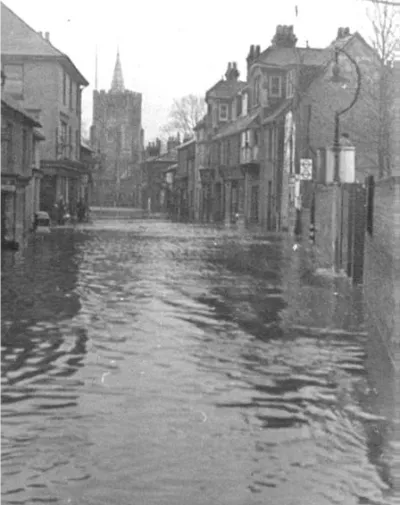
1948 Rickmansworth Darby and Joan Club founded.
1949 Women’s Voluntary Service (WVS) bought Croxley House to use as a residential club for 23 elderly people.
A Bronze Age archaeological find was made in Rickmansworth.
1950 Albert Freeman died. He was associated with local government in Rickmansworth for 50 years.
1951 Census: Rickmansworth UDC Population: 24,508; area: 7,639 acres.
Maple Lodge Sewage Treatment Works opened in May serving an area of 150 square miles.
Penn plaque unveiled at Basing House by the Hon William L Batt, Minister in Charge, ECA Mission to the UK.
Parsonage Farm sold after the death of Henry Gibson.
1952 (March) Watford to Rickmansworth Railway closed to passenger traffic.
New police station opened by the Home Secretary, Sir David Maxwell Fyfe at junction of Uxbridge and Rectory Roads.
Mill End junior school opened by Herts CC on the William Penn school site with Wilfred Broughton as headmaster.
1953 Rickmansworth UDC adopted the coat of arms below:
1954 Rickmansworth Historical Society founded with Godfrey Cornwall as its Chairman. The society adopted the drawing below by R. J. (Jim ‘Stick’) Walsh of the Old Market Hall as its logo.
1955 The first Rickmansworth Week.
Queen Elizabeth II visited The Royal Masonic School for Girls in Rickmansworth Park.
1957 Rickmansworth Odeon in the High Street closed.
William Penn Secondary School opened in Shepherds Lane.
1961 Electrification of the Metropolitan line from
Rickmansworth to Amersham and Chesham. The last steam-hauled Met train
ran between Rickmansworth and Amersham on 9th September.
1962 Church Street railway station and sidings closed to goods traffic.
1963 The Water Splash (Town Ditch) in Bury Lane bridged over.
1964 The Artists’ Rest Home and the other properties on Solomon’s Hill demolished; Penn Place shopping precinct and Ashleigh Court built.
1965 Odeon cinema demolished.
The ‘Bury Restaurant’ (a wartime British Restaurant) closed.
1966 The Swan Public House demolished.
Swannell & Sly offices (until 1912 The Bell Inn) demolished and replaced by Northway.
1967 A Locomotive Club of Great Britain special train came to Church Street Station, Rickmansworth (below).
1968 York House School moved from Money Hill House to Redheath, Sarratt Lane.
The new Rickmansworth Public Library opened by C G Ransome-Williams, Clerk to the UDC.
1972 The Limes demolished and Watersmeet built on the site.
1973 Lord Ebury’s railway line taken up and the station building demolished.
The Croxley Great Barn restored.
Work on the North Orbital Road between Rickmansworth & Watford (now part of the M25) commenced.
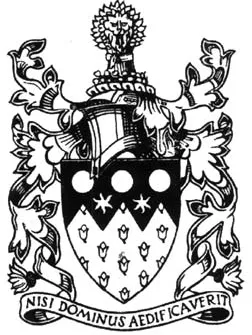
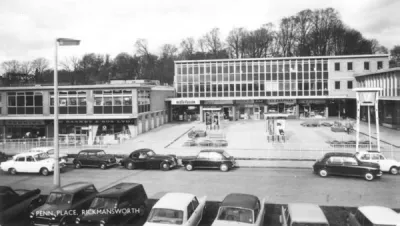
1974 Three Rivers District Council came into being.
1980 John Dickinson’s Croxley Paper Mill closed in December. Site bought by Marconi, the defence contractor, for offices and laboratories
1981 Chiltern Open Air Museum opened.
1982 Demolition of Croxley Mill completed.
1983 Godfrey Cornwall, founder and Chairman of the Rickmansworth Historical Society, died.
1984 The Methodist Church in the High Street demolished.
1987 Three Rivers Museum established on the initiative of Eddy Parrott.
1988 W.H. Walker, formerly boatbuilders and recently builders’, timber and coal merchants, closes, most noticeably their yard on Frogmoor Wharf.
The Beefeater restaurant chain buys and converts Scotsbridge Mill.
1989 Construction started for the new Council offices off Northway.
1990 Skidmore Way clinic opened.
1991 Franklin’s Mineral Water factory demolished. Marks and Spencer ‘food hall’ built on the site.
1992 Walker Brothers timber yard at Frogmoor Wharf, Harefield Road is bought by Tesco plc to build a supermarket.
1993 The first Rickmansworth Canal Festival, round the canal at Batchworth and in the Glade below Batchworth Bridge.
1994 Moor Park Golf Club members buy Moor Park Mansion from Three Rivers District Council.
1995 Chesswood Court built in Bury Lane, on part of the site of Beesons Yard.
1996 The Flour Milling and Baking Research Association (F.M.B.R.A.) establishment at Chorleywood, home of Chorleywood bread, closed.
1997 Building work started at The Bury, once the sixteenth century ‘home’ farm of the Manor of Rickmansworth, now saved from demolition and to be converted into seven flats.
Eddy Parrott, founding Chairman of the Museum, dies, and is succeeded by Barbara Owen.
1998 Demolition of the insurance office block built on the former site of Hutchings nursery, off the High Street. Hutchings Lodge, retirement apartments, built on the site.
Construction of Byewaters residential development on site of Croxley paper mill, now relinquished by Marconi, starts.
21st Century
2000 Population about 15,000.
Wright’s Garage demolished. Regus office block built on the site.
Penn Place apartment blocks built on the former site of Penn Place shopping precinct between Station Road and Northway.
Jackson’s Recording Studio at Maple Cross dismantled, taken to Chiltern Open Air Museum.
2002 Croxley Great Barn (1397) placed on the ‘Buildings at Risk’ Register by English Heritage.
2007 Waitrose supermarket opened on site of former sidings of Rickmansworth station.
2008 Key to Croxley Great Barn acquired by Three Rivers Museum from St Joan of Arc School. Monthly tours between April and October commence.
2009 Demolition of The Picture House in the High Street, which had been used as an office block. One apartment block built on the site.
2012 Silver Jubilee of Three Rivers Museum Trust, 1987-2012.
Hertfordshire Constabulary move the Police Station from the site in Rectory Road shared with the Fire and Rescue Service, and occupy part of Three Rivers House.
2013 Heritage Day celebrated as part of the national
Heritage Weekend in Basing House, on the initiative of the Chairman of
the Council.
Diamond Jubilee of the Rickmansworth Society, 1953-2013.
2014 Park Road, Rickmansworth is flooded for several days in February.
Several notable anniversaries occur:
Ricky Players celebrate 70 years.
Rickmansworth School celebrates 60 years.
Three Rivers District Council celebrates 40 years.
Rickmansworth Canal Festival (Rickmansworth Festival since 2006) celebrates 21 years.
(April) The twin gasometers at 57 and 58 Wharf Lane demolished. The 1957 date plate is presented to the Museum in June.
2019 (December) Barbara Owen, Chairman of the Museum since 1997, dies.
2020 COVID-19 causes major disruption in Three Rivers and across the country